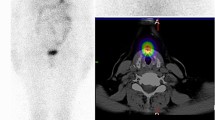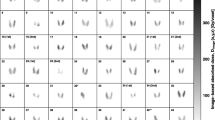Abstract
When planning treatment for Graves’ disease with 131I, the effective half-life (Teff) should be estimated individually as it depends on biological characteristics such as iodine uptake and excretion, which differ from an individual to another (Berg et al. 1996). All the methods to quantify Teff described in the literature are quite complex and are difficult to be used in clinical routine. With the aim of optimizing this process, a simplified method is proposed here to evaluate Teff of 131I during treatment of Graves’ disease. The present study suggests improving the method of determining Teff based on thermoluminescence dosimetry. This involves implementing a new method and includes reduction of TLD (Thermoluminescent Dosimeter) measurements. The proposed method was validated on patients with Graves’ disease. The radiation dose delivered to the patients was determined using the MIRD (Medical Internal Radiation Dosimetry) formalism. The relative difference between Teff obtained based on seven measurement intervals at [0–24 h, 24–48 h, 48–72 h, 72–96 h, 96–120 h, 120–144 h, 144–168 h] and based on three measurement intervals at [0–24 h, 72–96 h, 144–168 h] and [0–24 h, 120–144 h, 144–168 h] was 1.9% and 3.81%, respectively. Comparison of doses obtained based on a general Teff and on a personalized Teff gave a statistically significant difference with a correlation coefficient R2of 0.44. The Teff obtained from just three measurements was found to be sufficiently accurate and easily applicable. The results obtained demonstrate the need to determine and use personalized Teff values instead of using a fixed value of 7 days.








Similar content being viewed by others
Availability of data and materials
The data used are available at the Radiation Protection Center ‘CNRP’ and Clinic Elmanar of Tunis where the experiments were done.
References
Amato E, Lizio D, Baldari S (2009) Absorbed fractions in ellipsoidal volumes for β-radionuclides employed in internal radiotherapy. Phys Med Biol 54(13):4171–4180. https://doi.org/10.1088/0031-9155/54/13/013
Berg GE, Michanek AM, Holmberg EC, Fink M (1996) Iodine-131 treatment of hyperthyroidism: significance of effective half-life measurements. J Nucl Med 37(2):228–232
Berger M (1971) Distribution of absorbed dose around point sources of electrons and beta particles in water and other media. J Nucl Med 5:5–23
Desbrée A, Guyot M, Ricard M, Franck D, Aubert B, Challeton-de Vathaire C (2015) Estimation personnalisée de la dose après totalisation isotopique par l’131I chez un patient présentant un goitre endothoracique résiduel. Radioprotection 50(1):11–17. https://doi.org/10.1051/radiopro/2014029
European Society Therapeutic Radiology and Oncology (ESTRO) (2006), « Methods for in vivo Dosimetry in External Radiotherapy » . Booklet n°1
Glinoer D, Verelst J (1996) Utilisation de l’iode 131 pour le traitement des hyperthyroïdies chez l’adulte. Ann Endocrinol 57(3):177
Hosseini SM, Orouji T (2014) Evaluation of effective sources in uncertainty measurements of personal dosimetry by a Harshaw TLD system. J Biomed Phys 4(2):43–48
International Organization for Standardization and International Electrotechnical commission (ISO/IEC) (1991), « Thermoluminescence dosimetry for personal and environmental monitoring » . Standard 1066
Lama H (2011) Optimisation de la radioprotection en médecine nucléaire: De la dosimétrie de référence à la dosimétrie personnalisée. Thesis in university of Paris 7. https://www.irsn.fr/FR/Larecherche/Formation_recherche/Theses/Theses-soutenues/DRPH/Pages/2011-Hadid-radioprotection-medecine-nucleaire-dosimetrie.aspx#.YDYEO2hKjIU
Lawless MJ, Junell S, Hammer C, DeWerd LA (2013) Response of TLD-100 in mixed fields of photons and electrons. Med Phys 40:103–107. https://doi.org/10.1118/1.4773030
Liuzzi R, Savino F, D’Avino V (2015) Evaluation of LIF: Mg, Ti (TLD100) for intraoperative Electron Radiation Therapy Quality Assurance. Plos ONE J 10(10):1371–1382. https://doi.org/10.1371/journal.pone.0139287
Lyra M, Phinou P (2000) Internal Dosimetry in Nuclear Medicine:A Summary of its Development, Applications and Current Limitations. Radiation Safety Officier (RSO) Magazine 5(2): 1-26. https://www.academia.edu/25530094/Internal_Dosimetry_in_Nuclear_Medicine_A_Summary_of_Its_Development_Applications_and_Current_Limitations
Malone JF, Cullen MJ (1975) A thermoluminescent method for estimation of effective thyroidal half-life of therapeutic 131I in toxic goitre. Br J Radiol 48(573):762–764. https://doi.org/10.1259/0007-1285-48-573-762
Marchandise X, Beron-Nghi A (2010) Les Maladies de La Thyroïde. Fisrtedition, Elsevier-Masson, France 32–34.https://www.sciencedirect.com/book/9782294074646/les-maladies-de-la-thyroide
Mathieu I, Caussin J, Smeesters P, Wambersie A, Beckers C (1999) Recommended restrictions after 131I therapy: measured doses in family members. Health Phys 76(2):129–136
Muhammad W, Faaruq S, Hussain A (2007) Quantitive analysis of the factors responsible for over or under dose of 131I therapy patients of hyperthyroidism. Radiat Prot Dosimetry 128(1):90–97. https://doi.org/10.1093/rpd/ncm243
Pant G.S, Kumar R, Sharma S.K, Pandey A.K (2001) Estimation of effective half-life in patients with Graves disease. J. Med. Phys 26(2): 66–70. https://inis.iaea.org/search/searchsinglerecord.aspx?recordsFor=SingleRecord&RN=33035119
Reinhardt MJ, Joe A, vonMallek D, Zimmerlin M, Manka-Waluch A, Palmedo H, Krause TM (2002) Dose selection for radioiodine therapy of borderline hyperthyroid patients with multifocal and disseminated autonomy on the basis of 99mTc-pertechnetate thyroid uptake. Eur J Nucl Med Mol Imaging. 29(4):480–485. https://doi.org/10.1007/s00259-001-0722-0
Schvartz C (2006) Guide pour la rédaction de protocoles de traitement des hyperthyroïdies par iode 131. SFMN (France)
Sisson JC, Avram AM, Rubello D, Gross MD (2007) Radioiodine treatment of hyperthyroidism: fixed or calculated doses; intelligent design or science? Eur J Nucl Med Mol Imaging 34(7):1129–1130. https://doi.org/10.1007/s00259-007-0419-0
Traino AC, Xhafa B (2009) Accuracy of two simple methods for estimation of thyroidal 131I kinetics for dosimetry-based treatment of Graves’disease. Med Phys 36(4):1212–1218. https://doi.org/10.1118/1.3093237
Urban L (2002) Multiple scattering model in Geant4. RMKI (Hungary) CERN (Switzerland).https://cdsweb.cern.ch/record/592633/files/open-2002-070.pdf
van Gils K, Brinks P, Lavalaye J, Verberne HJ, Habraken JBA (2017) A method to measure the absorbed dose of the thyroid during I-131 therapy, using a collar detector system and a SPECT acquisition. Med Phys 44(10):5450–5456. https://doi.org/10.1002/mp.12472
Vasilache RA, Tanase-Nicola S, Tiron R (1999) Characteristics of TLD-100 fading and its influence on the calibration of personal dosemeters. Radiat Prot Dosimetry 85(1):183–185. https://doi.org/10.1093/oxfordjournals.rpd.a032831
Vynckier S, Wambersie A (1982) Dosimetry of beta sources in radiotherapy. I. The beta point source dose function. Phys Med Biol 27(11):1339–1347. https://doi.org/10.1088/0031-9155/27/11/004
Willegaignon J, Sapienza MT, Filho GBC, Traino AC, Buchpiguel CA (2013) Determining thyroid 131 I effective half-life for the treatment planning of Graves’ disease. Med Phys 40(2):502–507. https://doi.org/10.1118/1.4788660
Zanzonico PB (2000) Internal radionuclide radiation dosimetry: a review of basic concepts and recent developments. J Nucl Med 41:297–308
Zullo JR, Kudchadker RJ, Zhu XR, Sahoo N, Gillin MT (2010) LiF TLD-100 as a dosimeter in high energy proton beam therapy-can it yield accurate results ? Med Dosim 35(1):63–66. https://doi.org/10.1016/j.meddos.2009.03.001
Funding
The authors received no specific funding for this work.
Author information
Authors and Affiliations
Corresponding author
Ethics declarations
Conflict of interest
The authors declare that they have no conflict of interest.
Consent to participate
Before starting the measurements, an agreement was obtained from the participating patients; those who refused to put the TLDs on the neck were not included in this study.
Ethics approval
All procedures performed in the present study involving human participants were in accordance with the ethical standards of the 1964 Helsinki declaration and its later amendments or comparable ethical standards. All patients were properly informed of the objectives and the methods of the dosimetric study. Neither names, identifiers nor any personal data were used; only data collected were data relating to thyroid mass, iodine uptake, and radiation dose to the thyroid.
Additional information
Publisher's Note
Springer Nature remains neutral with regard to jurisdictional claims in published maps and institutional affiliations.
Rights and permissions
About this article
Cite this article
Meftah, S., Kraiem, T. A thermoluminescent method for the evaluation of the 131I effective half-life in the thyroid when treating Graves’ disease. Radiat Environ Biophys 60, 289–298 (2021). https://doi.org/10.1007/s00411-021-00907-9
Received:
Accepted:
Published:
Issue Date:
DOI: https://doi.org/10.1007/s00411-021-00907-9




